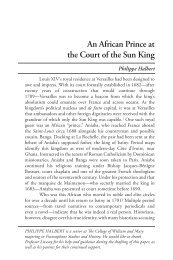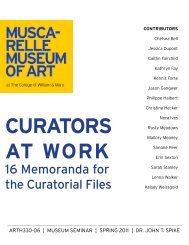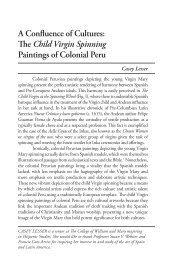Andean Artists in Colonial Quito: - College of William and Mary
Andean Artists in Colonial Quito: - College of William and Mary
Andean Artists in Colonial Quito: - College of William and Mary
Create successful ePaper yourself
Turn your PDF publications into a flip-book with our unique Google optimized e-Paper software.
48 The Monitor - W<strong>in</strong>ter 2011<br />
commission, which states that that sculpture was to be located “<strong>in</strong> the<br />
space <strong>of</strong> the altar where this is the holy crucifix” (Figure 2). 37<br />
The Dolorosa <strong>in</strong> Spa<strong>in</strong> <strong>and</strong> <strong>Quito</strong><br />
The popularity <strong>of</strong> the cult <strong>of</strong> the Dolorosa was on the rise <strong>in</strong> the<br />
Hispanic World dur<strong>in</strong>g the latter part <strong>of</strong> the seventeenth century, lead<strong>in</strong>g<br />
to an <strong>in</strong>crease <strong>of</strong> the depictions <strong>of</strong> the particular theme <strong>in</strong> pa<strong>in</strong>t<strong>in</strong>g <strong>and</strong><br />
sculpture. 38 In his 1670s bust, The Virg<strong>in</strong> <strong>of</strong> Sorrows (Mater Dolorosa),<br />
the famed Spanish sculptor, Pedro de Mena, depicts an anguished<br />
Dolorosa whose furrowed eyebrows, downcast eyes, <strong>and</strong> parted lips all<br />
convey emotional <strong>in</strong>tensity. 39 Particularly important is the way <strong>in</strong> which<br />
Mena portrays her face <strong>and</strong> h<strong>and</strong>s, as both exhibit remarkable level <strong>of</strong><br />
naturalism <strong>and</strong> attention to detail. The artist has carefully captured the<br />
reddened sk<strong>in</strong> tone that is so <strong>of</strong>ten associated with expressions <strong>of</strong> grief.<br />
Throughout the seventeenth century, the cult <strong>of</strong> the Dolorosa was<br />
so prevalent <strong>and</strong> <strong>in</strong> dem<strong>and</strong> that sculptural examples from the Spanish<br />
schools were exported from Spa<strong>in</strong> to Austria <strong>and</strong> even as far as Mexico. 40<br />
Given its position <strong>in</strong> the New World, <strong>Quito</strong> would also become an outpost<br />
for these pen<strong>in</strong>sular works <strong>of</strong> the Dolorosa. Discuss<strong>in</strong>g colonial sculpture,<br />
Gabrielle Palmer asserts: “Although <strong>in</strong>debted to the forms <strong>and</strong> techniques<br />
<strong>of</strong> the parent Andalucian sculpture, the Quitenian sculptors nonetheless<br />
exhibit a style <strong>and</strong> spirit entirely their own.” 41 Not<strong>in</strong>g that parallels to<br />
Spanish sculpture become <strong>in</strong>creas<strong>in</strong>gly difficult to make as the seventeenth<br />
century progresses, Palmer describes the pr<strong>in</strong>cipal characteristics <strong>of</strong><br />
Quiteñan sculpture as typically <strong>of</strong> the “de vestir type,” <strong>and</strong> possess<strong>in</strong>g a<br />
“highly polished encarnación,” or surface f<strong>in</strong>ish on the flesh tones. 42<br />
However, the “de vestir” or “clothed” sculpture is not solely a Quiteñan<br />
convention; a second Spanish Dolorosa proves that both Spa<strong>in</strong> <strong>and</strong> New<br />
World <strong>Quito</strong> practiced the dress<strong>in</strong>g <strong>of</strong> their sculptures. The anonymous<br />
sculpture <strong>of</strong> the Virgen de la Esperanza Macarena <strong>of</strong> the late seventeenth<br />
century also wears an elaborate garb, <strong>in</strong>clud<strong>in</strong>g a cream-colored wimple.<br />
This description certa<strong>in</strong>ly applies to the sculpture <strong>of</strong> the Dolorosa<br />
commissioned from Nicolas Pauca <strong>and</strong> Francisco Monga by Doctor Don<br />
Joseph Ramírez Dávila <strong>in</strong> 1693. Pauca <strong>and</strong> Monga’s Dolorosa is clearly<br />
an imagen de vestir, clad <strong>in</strong> a blue cloth garment, a black mantle edged <strong>in</strong><br />
lace, <strong>and</strong> a white wimple. Additionally, the face <strong>of</strong> the Dolorosa, somber








